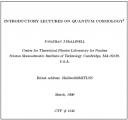
Introductory Lectures on Quantum Cosmology
by J. J. Halliwell
Publisher: arXiv 1990
Number of pages: 107
Description:
We describe the modern approach to quantum cosmology, as initiated by Hartle and Hawking, Linde, Vilenkin and others. The primary aim is to explain how one determines the consequences for the late universe of a given quantum theory of cosmological initial or boundary conditions. It also includes a detailed treatment of the WKB interpretation.
Download or read it online for free here:
Download link
(1.2MB, PDF)
Similar books
 Dynamics of the Universe in Problems
Dynamics of the Universe in Problemsby Yu. L. Bolotin, et al. - UniverseInProblems.com
Problem book on cosmology that includes its spectacular recent achievements. There are over 1000 problems, covering topics from the dynamics of the expanding Universe and CMB to cosmology beyond the Lambda-CDM model and holography.
(10816 views)
 Lectures on Inflation and Cosmological Perturbations
Lectures on Inflation and Cosmological Perturbationsby David Langlois - arXiv
Inflation is today the main theoretical framework that describes the early Universe. These lectures give an introduction to inflation and the production of primordial perturbations, and a review of some of the latest developments in this domain.
(10556 views)
 Applied Cosmography: A Pedagogical Review
Applied Cosmography: A Pedagogical Reviewby Yu. L. Bolotin, et al. - arXiv.org
Cosmography is in fact a kinematics of cosmological expansion. The effectiveness of cosmography lies in the fact that it allows, based on the observations, to perform a rigid selection of models that do not contradict the cosmological principle.
(5146 views)
 Modified Gravity and Cosmology
Modified Gravity and Cosmologyby T. Clifton, P.G. Ferreira, A. Padilla, C. Skordis - arXiv
In this review we present a thoroughly comprehensive survey of recent work on modified theories of gravity and their cosmological consequences. We cover General Relativity, Scalar-Tensor, Einstein-Aether, Bimetric theories, TeVeS, Galileons, etc.
(10872 views)